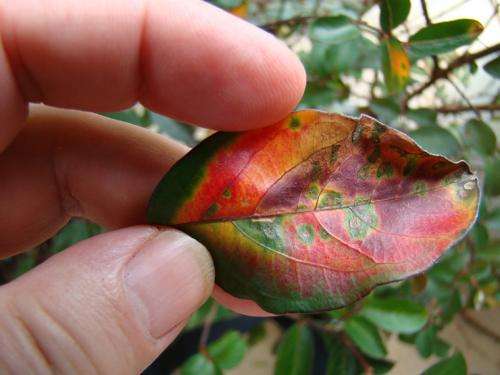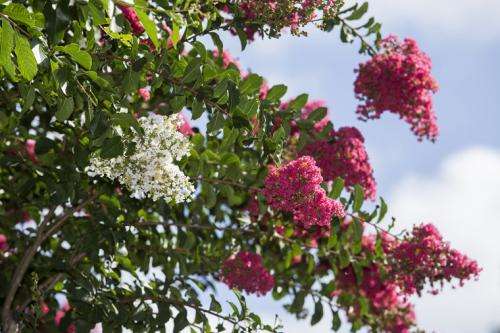Beloved crape myrtle in nurseries now susceptible to bacterial leaf spot, researchers say

It's enough to send gardeners into conniptions. Crape myrtle, a tree adored for its bright flowers that scream summer, care-free maintenance and even its colorful bark, now has a disease problem – although so far, only in the commercial nursery setting.
University of Florida researchers had been getting sporadic reports from nursery owners over the last five years of a leaf spot problem, and those reports have only increased in frequency. Through genetic testing, scientists identified the disorder as being caused by the bacterium Xanthomonas axonopodis. The disease is most likely spread by wind-driven rain or overhead irrigation, and some crape myrtle varieties are more susceptible than others.
"I've been working with crape myrtles for a long time, and they've been such a disease-resistant plant for such a long time, so it's pretty significant when their susceptibility to disease is increased," said Gary Knox, an environmental horticulture professor with UF's Institute of Food and Agricultural Sciences.
The U.S. crape myrtle crop had a value of nearly $43 million in 2010, and Florida is its second-biggest producer, behind Texas. Florida has more companies producing crape myrtle, however, with 130 compared with 72 in Texas.
In the June issue of the journal Plant Disease, the UF/IFAS team outlined the first report of the disease and the work they did to identify it. They believe it is the first report of the bacterium causing leaf spot in crape myrtle.
Bacterial leaf spot doesn't kill the ornamental tree, but creates spots on its leaves that eventually turn yellow and drop.
The researchers say, for now, the disease affects only crape myrtle commercial producers and is spread by factors such as overhead irrigation systems and large numbers of plants kept in close quarters.

The bad news is that the bacterium is widespread.
"I think you can safely say that nearly every crape myrtle producer would have the disease at this point," Knox said.
While the disease appears contained in the commercial sector, that could change.
"Most bacterial diseases can be spread in wind-driven rain, and in Florida, we know there's no shortage of that," said Mathews Paret, an assistant professor of plant pathology who led the study.
Paret and Knox are based at the North Florida Research and Education Center in Quincy.
Scientists suggest an integrated management approach to the problem, rather than a silver bullet that only stops the problem temporarily.
Choosing resistant varieties, moving from overhead irrigation to drip irrigation and the limited use of bactericides would be part of such an integrated strategy, the researchers said.
The varieties Natchez, Osage, Fantasy, Basham's Party Pink and Miami have proven highly resistant to bacterial leaf spot while Carolina Beauty, Arapaho, Tuscarora, White Chocolate, Red Rocket and Rhapsody in Pink were more susceptible in field trials funded by the Florida Nursery Growers and Landscape Association.
Steve Bender, a senior writer at Southern Living magazine, "The Grumpy Gardener" blogger and well-known gardening author, says it would be a huge disappointment if the disease ever makes the leap from nurseries to home gardens.
Crape myrtle is so close to Southern gardeners' hearts that they endlessly debate such topics as how to spell its name (variants include crepe myrtle, crape myrtle and even crapemyrtle), and the annual rite Bender calls "crape murder" – an unceremonious lopping of its limbs.
It's an iconic tree, he said, mostly because it's little work for a big payoff.
"It's ideally suited to the southern climate, it blooms for a long time, it comes in lots of different colors and you even get nice color in the fall," Bender said. "It's kind of hard to kill, and pretty much any idiot can grow one. And up until now, it's had very few problems."
Provided by University of Florida















